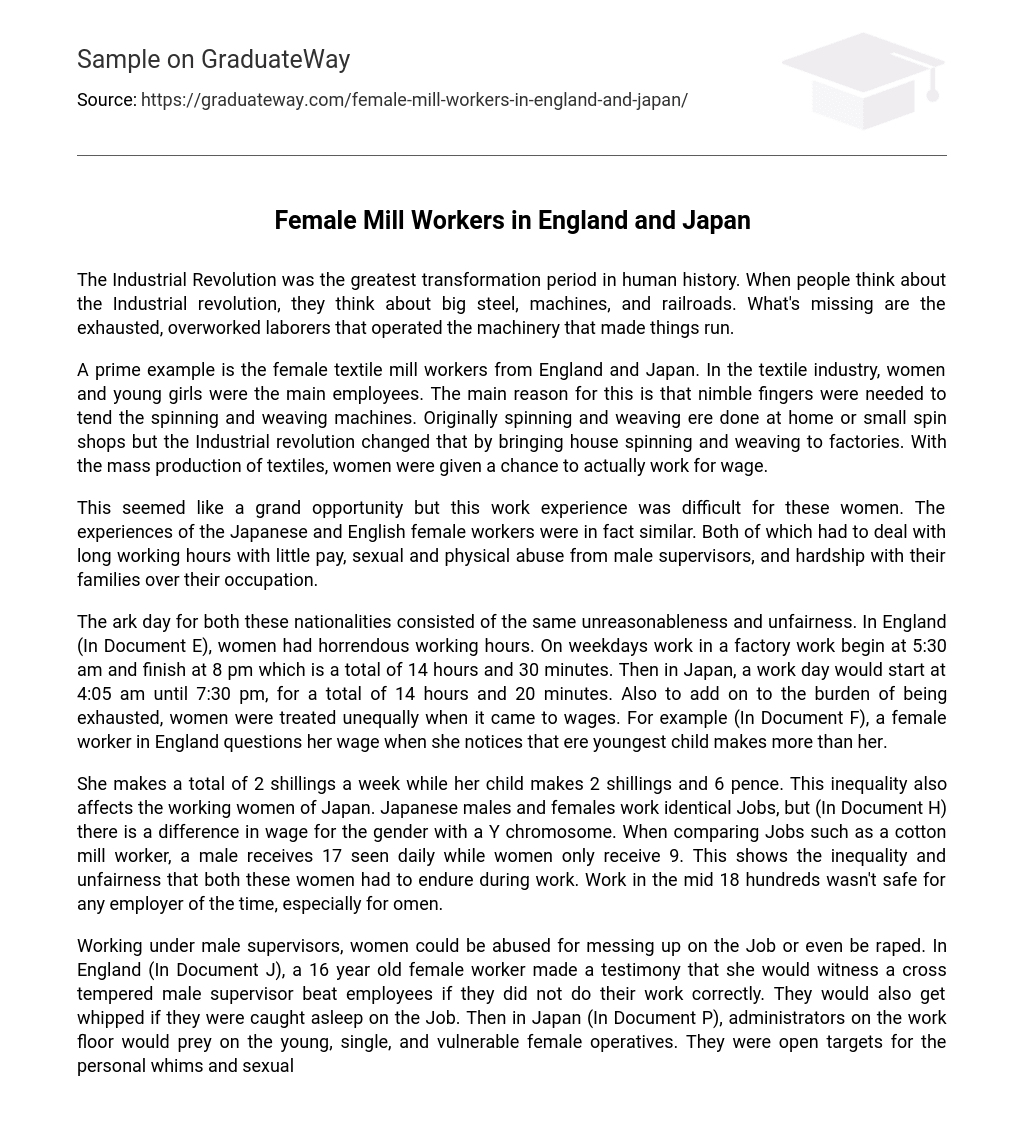The Industrial Revolution was the greatest transformation period in human history. When people think about the Industrial revolution, they think about big steel, machines, and railroads. What’s missing are the exhausted, overworked laborers that operated the machinery that made things run.
A prime example is the female textile mill workers from England and Japan. In the textile industry, women and young girls were the main employees. The main reason for this is that nimble fingers were needed to tend the spinning and weaving machines. Originally spinning and weaving ere done at home or small spin shops but the Industrial revolution changed that by bringing house spinning and weaving to factories. With the mass production of textiles, women were given a chance to actually work for wage.
This seemed like a grand opportunity but this work experience was difficult for these women. The experiences of the Japanese and English female workers were in fact similar. Both of which had to deal with long working hours with little pay, sexual and physical abuse from male supervisors, and hardship with their families over their occupation.
The ark day for both these nationalities consisted of the same unreasonableness and unfairness. In England (In Document E), women had horrendous working hours. On weekdays work in a factory work begin at 5:30 am and finish at 8 pm which is a total of 14 hours and 30 minutes. Then in Japan, a work day would start at 4:05 am until 7:30 pm, for a total of 14 hours and 20 minutes. Also to add on to the burden of being exhausted, women were treated unequally when it came to wages. For example (In Document F), a female worker in England questions her wage when she notices that ere youngest child makes more than her.
She makes a total of 2 shillings a week while her child makes 2 shillings and 6 pence. This inequality also affects the working women of Japan. Japanese males and females work identical Jobs, but (In Document H) there is a difference in wage for the gender with a Y chromosome. When comparing Jobs such as a cotton mill worker, a male receives 17 seen daily while women only receive 9. This shows the inequality and unfairness that both these women had to endure during work. Work in the mid 18 hundreds wasn’t safe for any employer of the time, especially for omen.
Working under male supervisors, women could be abused for messing up on the Job or even be raped. In England (In Document J), a 16 year old female worker made a testimony that she would witness a cross tempered male supervisor beat employees if they did not do their work correctly. They would also get whipped if they were caught asleep on the Job. Then in Japan (In Document P), administrators on the work floor would prey on the young, single, and vulnerable female operatives. They were open targets for the personal whims and sexual abuse by these low-ranking previous.
What made matters even worse was that owners and managers were more abusive than ordinary workers and they usually had keys to the women’s dormitory rooms. Women had no chance of a decent time at work because of the dominant male figures that ran the factory.
Female workers experienced enough grief at the work place so to make matters worse, they received grief at home. In England (In Document M young women were Delve craterlike Tort naval Sods Wendell men don’t. This is mostly because women weren’t dependent on their families anymore and able to support themselves at such a young age.
This sense of independence wasn’t normal to the people with medieval thinking, which made it a bad thing. Also (In Document N), it was considered a disgrace for parent’s to send their children to work. Since families were so accustom to the old family life were parent’s worked and children went to school. In fact the title of “factory girl” was considered the most insulting name that could be applied to a young woman. It was also believed that if a girl worked in a factory that she would never find work anywhere else. With superstitions and old ways of thinking, it made things hard for women in their family life.
Life of both Japanese and English female workers was difficult, personally and in the work place. The situations these women were in had some definite similarities when it came to long hours with little pay, abuse, and grief with their families. These things showed how difficult it was for society to get used to the idea of women being appreciated and actually valued for something. Plus it could be considered the first steps for equality for women.





